В Baldur’s Gate 3 классы – это базис любого персонажа, на основе которого затем подбираются способности, навыки, заклинания, фокусы, боевые стили и другие характеристики героя. Нередко они также определяют поведение и мировоззрение протагониста, если есть желание отыгрывать выбранную роль.
В этом руководстве будет раскрыта основа классовой системы игры. Вы узнаете про особенности, плюсы и минусы всех архетипов, и их подклассы. Мы также затронем тему мультиклассов и дадим советы по выбору оптимальных классов для новичков.
Базовая информация по классам в Baldur’s Gate 3
Выбранный класс оказывает серьезное влияние на игровой процесс, так как от него зависит не только стиль боя (использование заклинаний или боевых навыков, к примеру), но и доступ к определенному снаряжению, то есть чародей не сможет пользоваться тяжелой броней, а варвару противопоказаны кинжалы. Плюс, в диалогах могут появляться дополнительные варианты ответов. По этой причине следует внимательно отнестись к подбору архетипа.
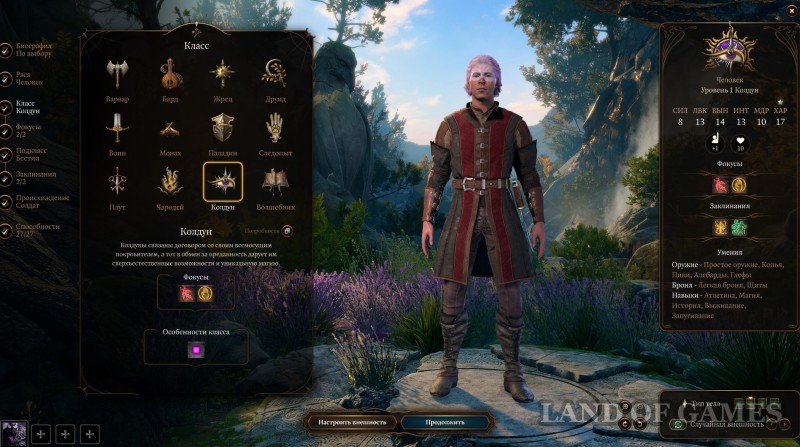
Примечание: Впрочем, даже если через несколько часов игры вы поймете, что выбрали не тот класс или неправильно прокачали способности, то не нужно сильно беспокоиться об этом, так как вам удастся относительно легко сменить архетип или сбросить очки умений.
Подклассы и мультиклассы
Не стоит также забывать про подклассы, которые тоже способны значительно повлиять на геймплей. К примеру, жрец необязательно должен быть направлен на лечение – если вы выберите сабкласс «Домен бури», то сможете превратить его в атакующего дебаффера, ослепляющего врагов или наносящего им урон громовой волной.
Что касается сроков открытия подклассов, то у колдуна, жреца, паладина и чародея их можно выбрать уже при создании персонажа. На втором уровне они становятся доступны у волшебника, воина и друида, а на третьем – у плута, варвара, барда, монаха и следопыта.
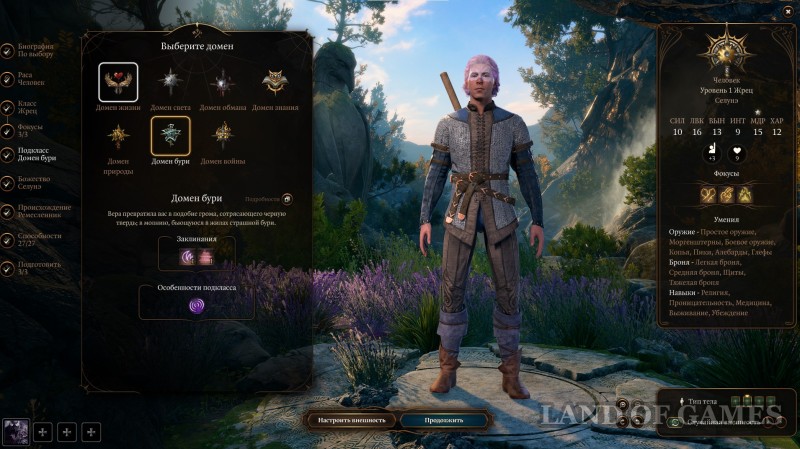
Есть также мультиклассовая система, которая еще сильно расширяет возможности игроков по созданию идеального персонажа. Не нравится, что ваш волшебник умирает с полпинка из-за отсутствия крепкой брони и низкой выносливости? Тогда объедините его с воином. Хотите, чтобы ваш колдун мог умело вскрывать замки и прятаться от врагов? В этом случае выберите вторым классом плута.
Комбинаций очень много, поэтому экспериментировать можно практически бесконечно. Однако мы не рекомендуем заниматься этим новичкам, которые до этого ни разу не играли в подобные ролевые проекты, так как есть немалый шанс ошибиться и получить слабого героя.
Характеристики
У каждого класса имеется своя основная способность (отмечена звездочкой), считающаяся самой важной его характеристикой, так как именно от нее будет зависеть шанс попадания по противникам оружием или заклинанием, а также наносимый вами урон.
По этой причине в большинстве случаях основное внимание следует уделять повышению именно этого атрибута. К примеру, жрецу, который направлен только на лечение, необходимо по максимуму прокачать Мудрость, а вот при выборе подкласса «Домен войны» есть смысл повышать Силу и Выносливость, чтобы увеличить боевой потенциал героя.
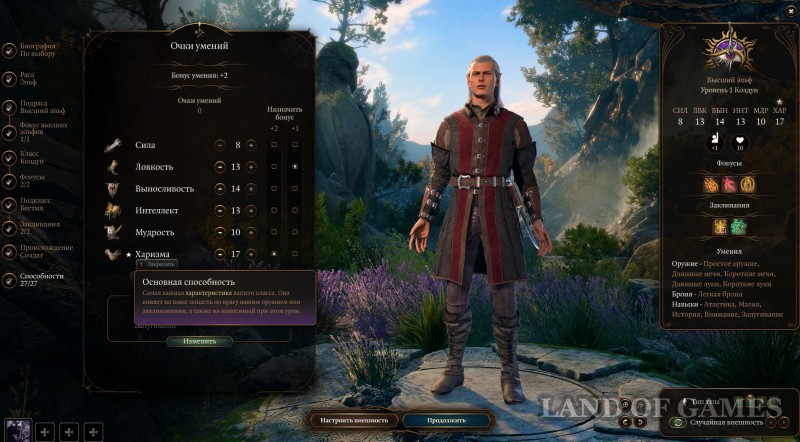
Так что повышайте атрибуты, основываясь на своем будущем стиле игры. Что касается бонусов +2 и +1, то они позволяют получить дополнительные очки умений для тех или иных характеристик. Если снова брать в пример жреца с сабклассом «Домен войны», то вы можете, к примеру, взять бафф на +2 к Силе, а на +1 к Мудрости или наоборот.
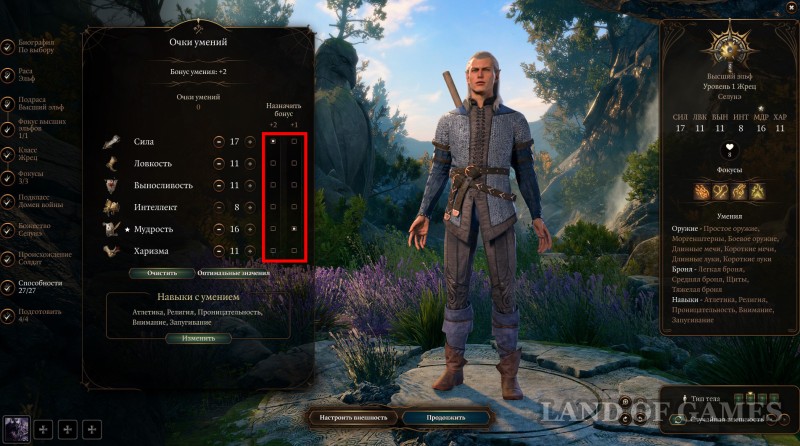
В списке ниже указано, на что оказывает влияние каждый из атрибутов:
- Сила – влияет эффективность использования оружия ближнего боя (урон) и тяжелой брони, как далеко вы сможете прыгнуть и сколько сможете унести.
- Ловкость – влияет на эффективность использования дальнобойного и фехтовального оружия (урон), а также на инициативу и класс брони (легкая и средняя).
- Выносливость – влияет на максимальное количество очков здоровья.
- Интеллект – влияет на эффективность сотворения заклинаний у волшебников.
- Мудрость – влияет на эффективность сотворения заклинаний у друидов, жрецов и следопытов.
- Харизма – влияет на эффективность сотворения заклинаний у бардов, паладинов, чародеев и колдунов.
Следует также знать, что каждая характеристика влияет на успешность спасбросков в тех или иных ситуациях. К примеру, вы с большей вероятностью сможете убедить собеседника при высокой Харизме или меньше будете подвержены болезням при повышенной Выносливости.
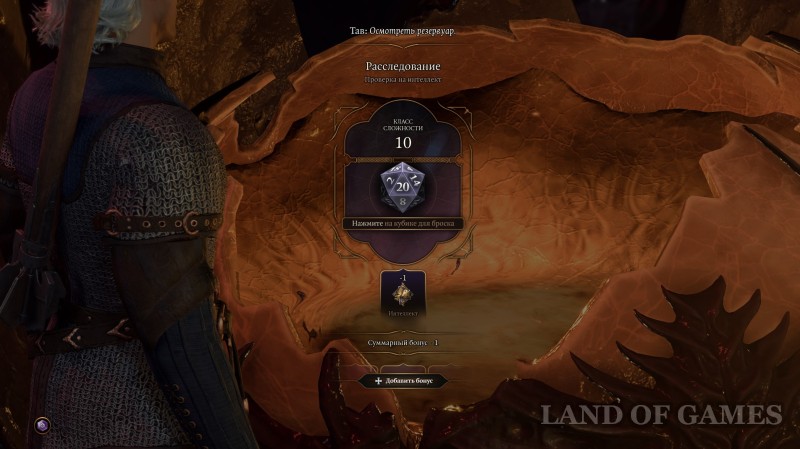
Навыки с умением
От выбранного класса и происхождения (иногда расы) будет зависеть доступ к тем или иным навыкам. Речь идет об особых умениях, которые дают бонус к проверкам характеристик, увеличивая вероятность успеха, а также наделяют особыми баффами. Например, если вы выбрали Убеждение при высокой Харизме, то в большинстве случаях сможете без проблем уговаривать других людей.
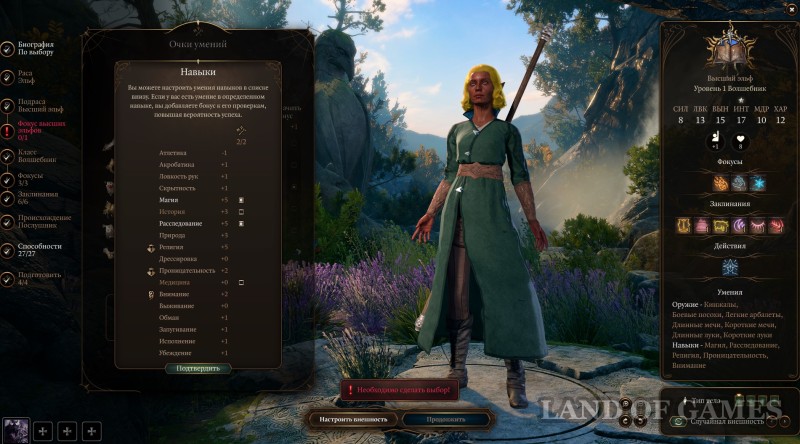
- Атлетика (Сила) – помогает толкать и мешает тому, чтобы вас оттолкнули. Доступно плутам, следопытам, воинам, бардам, варварам, монахам и паладинам.
- Акробатика (Ловкость) – мешает другим оттолкнуть вас. Доступно плутам, воинам, бардам и монахам.
- Ловкость рук – помогает красть из карманов, взламывать замки и обезвреживать ловушки. Доступно плутам и бардам.
- Скрытность – помогает прятаться. Доступно плутам, следопытам, бардам и монахам.
- Магия – помогает распознавать магию и взаимодействовать с зачарованными объектами. Доступно бардам, друидам, волшебникам, чародеям и колдунам.
- История – помогает узнавать прошлое мира и населяющих его народов. Доступном волшебникам, воинам, бардам, колдунам, монахам и жрецам.
- Расследование – помогает в анализе улик и разгадывании тайн. Доступно волшебникам, колдунам, бардам, следопытам и плутам.
- Природа – помогает в распознавании растений и зверей. Доступно колдунам, варварам, друидам, следопытам и бардам.
- Религия – помогает в распознавании богов и ритуалов. Доступно волшебникам, колдунам, монахам, бардам, жрецам, друидам, паладинам и чародеям.
- Дрессировка – помогает влиять на животных. Доступно следопытам, бардам, варварам, друидам, воинам и варварам.
- Проницательность – помогает просчитывать людей и распознавать ложь. Доступно волшебникам, воинам, бардам, монахам, паладинам, жрецам, друидам, плутам и чародеям.
- Медицина – помогает распознавать симптомы и диагностировать болезни. Доступно волшебникам, бардам, друидам, паладинам и жрецам.
- Внимание – помогает наблюдать за окружением и замечать скрытые детали (полезно при решении головоломок). Доступно плутам, воинам, бардам, варварам, следопытам и друидам.
- Выживание – помогает выживать в дикой природе и выслеживать добычу. Доступно следопытам, воинам, варварам, друидам и бардам.
- Обман – помогает лгать, обманывать и манипулировать правдой. Доступно колдунам, бардам, плутам и чародеям.
- Запугивание – помогает угрожать, вызывать страх и вести себя агрессивно. Доступно колдунам, воинам, варварам, бардам, плутам, паладинам и чародеям.
- Исполнение – помогать развлекать зрителей. Доступно плутам и бардам.
- Убеждение – помогает упрашивать и убеждать собеседников, используя свое обаяние. Доступно чародеям, бардам, плутам, жрецам и паладинам.
Крайне рекомендуем вам выбрать Внимание в случае его доступности, так как он заметно упростит исследование мира и разгадывание загадок. Среди навыков, связанных с Харизмой, берите тот, который открыт для вашего класса. Если доступно несколько, то возьмите тот, который больше подходит отыгрышу выбранной роли, то есть добрякам следует брать Убеждение, хитрецам – Обман, а злодеям – Запугивание.
Как сменить класс и сбросить очки умений
Вам нужно отыскать Иссохшего в своем лагере, чтобы за деньги поменять класс (подкласс) и/или сбросить очки навыков. Сменить его можно не только у главного героя, но и у своих спутников. Данная возможность появляется не сразу – в отдельном руководстве мы рассказали, что необходимо для этого сделать.
Все классы в Baldur’s Gate 3
На данный момент времени в игре присутствуют 12 классов и 46 подклассов. Ниже мы рассмотрим их все, указав основные характеристики, навыки, рекомендуемые расы, используемое снаряжение, основные функции в отряде, а также преимущества и недостатки. На основе этих данных можно предварительно выбрать себе подходящий архетип.
Варвар
- Роль в команде: дамагер ближнего боя и/или танк
- Основная характеристика: Сила
- Вторая по важности характеристика: Выносливость
- Особенности: Защита без брони
- Доступные навыки: Атлетика, Природа, Дрессировка, Внимание, Выживание и Запугивание
- Рекомендуемые расы: человек, драконорожденный, гитьянки, дварф, полурок, тифлинг
- Спутник данного класса: Карлах
- Ранг: A
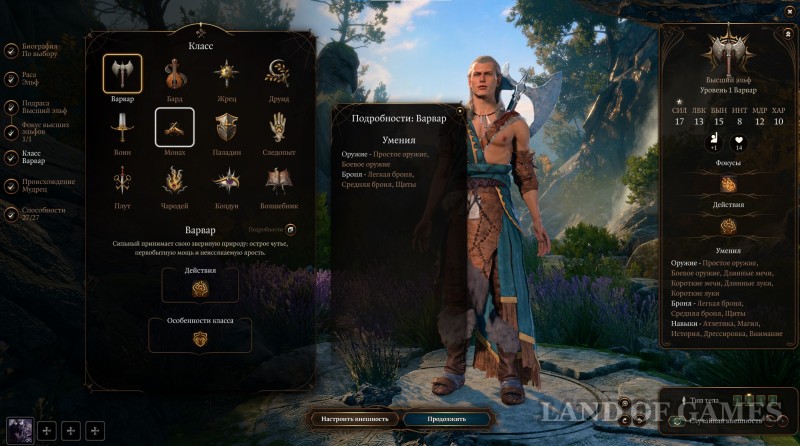
Варвар немного похож на Воина – он наносит больше урон, но менее разнообразен в плане тактики. Его необходимо кидать в самую гущу сражения, тригеря у него Ярость, которая увеличивает наносимые им повреждения и живучесть, однако не позволяет использовать заклинания и концентрироваться. Без этого действия у персонажа могут возникнуть трудности из-за малого выбора умений.
| Плюсы | Минусы |
|---|---|
| Может нанести значительный урон в ближнем бою. | Бесполезен, если враг находится далеко. |
| Обладает наибольшим приростом здоровья. | Нужно постоянно поддерживать Ярость. Может быстро умереть, если не следить за ним в тяжелой битве. |
| Класс брони повышается в зависимости от Выносливости. | Не приспособлен для тяжелой брони. |
| Малый набор способностей. |
Подклассы
- Берсерк – после впадения в Ярость может за один раунд атаковать цель несколько раз и сбить ее с ног. Лучший вариант для варвара, так как дает ему возможность наносить огромный урон.
- Дикое сердце – способен говорить со зверьми и использовать способности от тотемных духов: лось (таран), орел (передвижение), волк (бонусы к спасброскам), тигр (размашистый удар) и медведь (выживание).
- Дикая магия – при впадении в Ярость варвар начинает творить случайные заклинания из определенного списка.
Бард
- Роль в команде: заклинатель саппорт, баффающий союзников и дебаффающий врагов
- Основная характеристика: Харизма
- Вторая по важности характеристика: Ловкость
- Особенности: Открыты ячейки заклинаний 1-го круга
- Доступные навыки: Все
- Рекомендуемые расы: полурослик, эльф, полуэльф, тифлинг, дроу, гном
- Спутник данного класса: отсутствует
- Ранг: S

Крайне полезный класс для любого отряда, за которого к тому же довольно увлекательно играть. Он может использовать множество заклинаний на лечение, контроль толпы и поддержку союзников, но при этом более живущий, чем другие саппорты. При желании можно и вовсе убрать из его арсенала атакующие заклинания, избегая столкновений с помощью фокусов и очарования. Если попытаться собрать Барда на интеллект, то геймплей за него станет еще более вариативным.
| Плюсы | Минусы |
|---|---|
| Универсальный саппорт, усиливающий союзников и ослабляющий врагов. | Не способен наносить большой урон. |
| Может избежать боя благодаря высокой Харизме и прокаченным навыкам Обмана, Запугивания, Исполнения и Убеждения. | Может потребоваться больше времени на раскрытие его полного потенциала, чем у других архетипов. |
| Для некоторых заклинаний требуется поддержка концентрации. |
Подклассы
- Коллегия доблести – позволяет использовать средние доспехи, боевое оружие и щиты, а Вдохновляющая речь дает бонус к атаке союзников. Самый оптимальный сабкласс для Барда, так как повышает его атакующие возможности и эффективность в качестве саппорта.
- Коллегия знаний – повышает запугивание, магию и ловкость рук, а также позволяет выучить заклинание любого другого класса на 6-м левеле. Его умения начнут создавать штраф к броскам вражеских атак.
- Коллегия мечей – позволяет использовать скимитар и среднюю броню, а также наносить дополнительный удар, подобрать боевой стиль (парное оружие, дуэлянт). Плюс, он увеличивает скорость передвижения после выполнения атаки.
Жрец
- Роль в команде: заклинатель саппорт и/или хиллер
- Основная характеристика: Мудрость
- Вторая по важности характеристика: Сила
- Особенности: Открыты ячейки заклинаний 1-го круга и Заклинания домена
- Доступные навыки: История, Религия, Проницательность, Медицина и Убеждение
- Рекомендуемые расы: гном, эльф, полуэльф, человек, дроу, дварф и тифлинг
- Спутник данного класса: Шэдоухарт
- Ранг: S
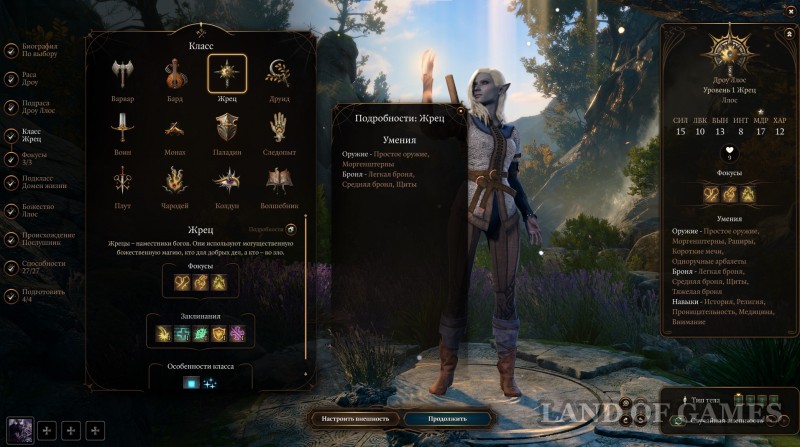
Способен не только лечить своих союзников, но также наносить неплохой урон врагам как с помощью заклинаний, так и своим оружием. При этом он весьма живуч, так как при определенных условиях может использовать даже тяжелую броню. В итоге получается весьма гибкий класс, который можно настроить под любую ситуацию.
| Плюсы | Минусы |
|---|---|
| Универсальный саппорт и прекрасный хиллер с полезными заклинаниями. | Довольно мало свободных ячеек под заклинания. |
| Обладает значительным запасом здоровья и прочностью. | Имеет зависимость от выбранного божества. |
| Может повышать вероятность успешного броска кубика у союзников. | Не стоит ждать от него очень высокого урона. |
Подклассы
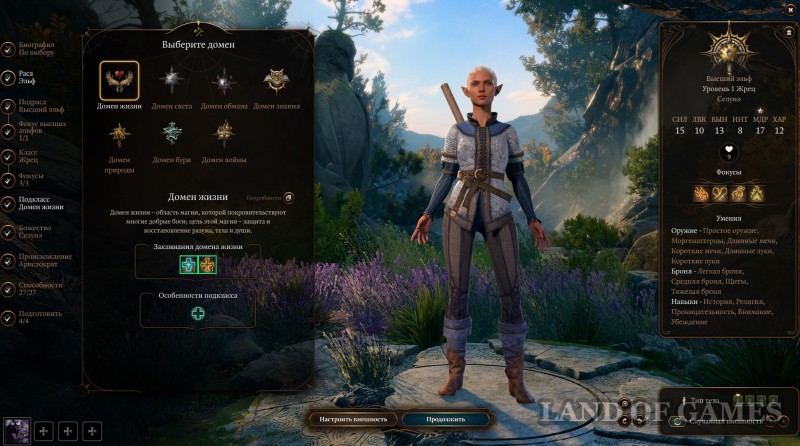
- Домен жизни – улучшает целительные способности Жреца и позволяет ему носить тяжелые доспехи, что весьма полезно, если вы не качали Ловкость. Один из лучших сабклассов для данного архетипа.
- Домен знания – дает доступ к большему количеству навыков и позволяет на время изучать новые способности. Еще один неплохой сабкласс для Жреца.
- Домена света – позволяет накладывать на врагов дебафф на промах, а также дает бонус к броскам на атаку и возможность воспламенить цель.
- Домен обмана – может давать бонусы к скрытности и харизме, а также очаровывать гуманоидных врагов. С помощью иллюзии можно изменять детали своей внешности.
- Домен природы – превращает дубину или посох в магическое оружие, повышает навыки друида (Выживание, Природа и Дрессировка), а также позволяет говорить с животными и очаровывать их. Можно носить тяжелую броню.
- Домен бури – наделяет контрударом молнией и громом, а также заклинаниями, наносящими громовой урон и ослепляющий врагов. Можно носить тяжелую броню.
- Домен войны – дает дополнительную атаку, повышает класс брони союзника, наделяет атаки дополнительным лучистым уроном. Можно носить тяжелую броню.
Друид
- Роль в команде: саппорт с заклинаниями природы и оборотень (танк)
- Основная характеристика: Мудрость
- Вторая по важности характеристика: Выносливость или Ловкость
- Особенности: Открыты ячейки заклинаний 1-го круга
- Доступные навыки: Магия, Природа, Дрессировка, Медицина и Выживание
- Рекомендуемые расы: человек, эльф, полуэльф, гном и тифлинг
- Спутник данного класса: Хапсин, Джахейра
- Ранг: B
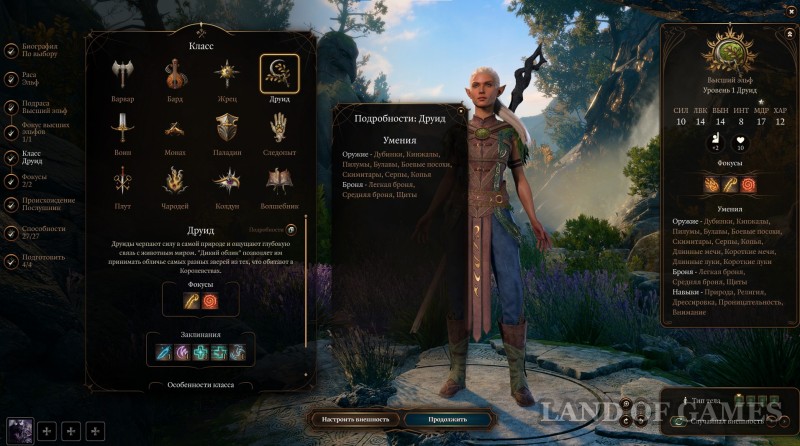
Главной особенностью класса является возможность превращения в зверя, который как бы дает персонажу вторую полоску здоровья, то есть после нокаута животного друид попросту снова возвращается в оригинальную форму. В обычном состоянии этот архетип может кастовать несколько полезных поддерживающих и атакующих заклинаний, однако он все равно уступает в этом плане барду, жрецу или атакующему магу.
| Плюсы | Минусы |
|---|---|
| Довольно универсальный персонаж, способный как танковать, так и поддерживать отряд. | Наносит меньше урона, чем полноценный дамагер. |
| Может превращаться в сильного зверя, не завися от скиллов. | Заклинаний не очень много, а полезных и того меньше. |
Подклассы
- Круг Луны – усиливает звериную сторону друида, позволяя им исцелять себя, находясь в форме животного. На начальном этапе может превращаться в бурого мишку и ворона, а в конце открывается невероятно сильный белый медведь. Лучший подкласс.
- Круг Земли – дает возможность восстановить 1 слот заклинаний с помощью медитации и получить особенные заклинания 3-го круга при выборе места посвящения. Усиливает магическую сторону друида.
- Круг спор – наделяет друида некромагией, позволяя ему поднимать мертвые тела и наносить урон с помощью спор. Самый неоднозначный сабкласс.
Воин
- Роль в команде: физический дамагер ближнего боя с повышенной живучестью
- Основная характеристика: Сила
- Вторая по важности характеристика: Выносливость
- Особенности: отсутствуют
- Доступные навыки: Атлетика и Запугивание
- Рекомендуемые расы: человек, гитьянки, дварф, драконорожденный и полуорк
- Спутник данного класса: Лаэзель
- Ранг: A

Простой в использовании класс, который может и урон нанести и союзников защитить. Плюс, с ним можно использовать разные типы брони и оружия, качая при необходимости Силу или Ловкость. Однако ничего экстраординарного ждать от него не стоит, то есть в одиночку изменить ход битвы он не сможет. Если вы планируете держать в отряде Лаэзель, то делать героя воином мы не рекомендуем.
| Плюсы | Минусы |
|---|---|
| Может использовать различные типы оружия и брони. | Отсутствуют заклинания. |
| Обладает высокой выносливостью, а, следовательно, запасом здоровья. | Значительно зависит от используемой экипировки. |
| Прост в освоении, поэтому подходит новичкам. | Отсутствует тактическая глубина в бою. Во время разговоров и расследований он выглядит довольно скучным. |
Подклассы
- Мастер боевых искусств – наделяет Воина кубиком превосходства, который может нанести урон, контратаковать или усилить союзника. Универсальный сабкласс, усиливающий все основные аспекты архетипа.
- Потусторонний рыцарь – наделяет Воина заклинаниями, направленными на усиление оружие или брони. Есть также атакующие спеллы. Однако для их усиления потребуется качать Интеллект, что может ухудшить другие показатели класса.
- Чемпион – повышает физическую силу и критический урон. Наиболее прямолинейный и простой в освоении сабкласс, который можно выбрать новичкам.
Монах
- Роль в команде: боец ближнего боя, полагающийся на скорость
- Основная характеристика: Ловкость
- Вторая по важности характеристика: Мудрость и Выносливость
- Особенности: Ци, защита без брони, а также боевые искусств (ловкие атаки, искусные удары и бонусная атака без оружия)
- Доступные навыки: Акробатика, Атлетика, Скрытность, Религия, История и Проницательность
- Рекомендуемые расы: человек, гитьянки, дварф, драконорожденный, полуорк, лесной эльф, лесной полуэльф и тифлинг
- Спутник данного класса: отсутствует
- Ранг: С
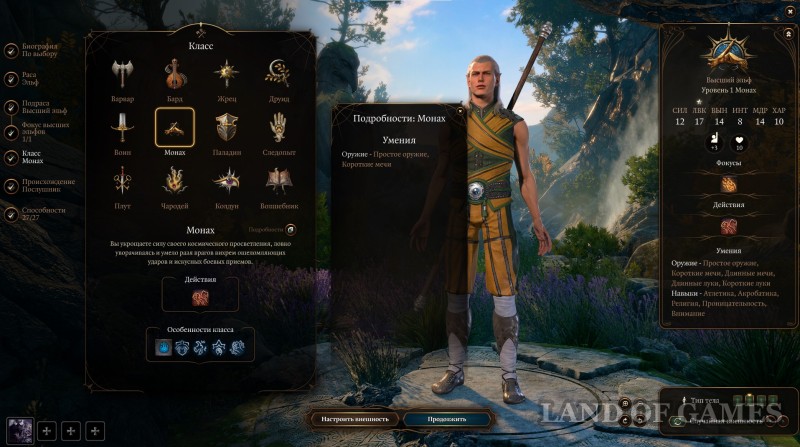
Монах понравится тем, кто любит продумывать каждый свой ход до мелочей. В плане боя похожи на Плутов, так как им тоже требуется элемент внезапности для успешной атаки. Плохо показывают себя при сражении с врагами на дальних дистанциях. В таких битвах энергию Ци следует направлять на увеличение скорости перемещения. Можно также выбрать в качестве расы лесного эльфа (полуэльфа), способные быстрее передвигаться по полю сражения.
| Плюсы | Минусы |
|---|---|
| Практически не зависит от экипировки, так как не использует броню и оружие. | Уступает другим дамагерам в плане нанесения урона. |
| Обладает высокой скоростью и мобильностью. | Не подходит для сражения с врагами на дальних дистанциях. |
| Из него сложно сделать хиллера. | |
| Энергия Ци довольно быстро тратится и ей требуется время на восстановление. |
Подклассы
- Путь Четырех стихий – позволяет Монаху использовать некоторые заклинания из других школ. Тем самым вам удастся наделить его дальнобойными атаками, что упростит сражения с некоторыми противниками. Оптимальный сабкласс.
- Путь открытой ладони – усиливает Монаха в ближнем бою, позволяя ему накладывать на цели метки Ци, проводить цепочки ударов, сбивать врагов с ног или толкать их.
- Путь тени – усложняет обнаружение Монаха противниками, позволяя ему незаметно проскальзывать мимо них. Получает Шаг в тени, являющийся особым действием, с помощью которого персонаж сможет телепортироваться из сумрака, возникнув прямо рядом с целью и выполнив по нему атаку.
Паладин
- Роль в команде: целитель, танк, боец ближнего боя и заклинатель
- Основная характеристика: Сила
- Вторая по важности характеристика: Харизма
- Особенности: Заряды силы клятвы 1
- Доступные навыки: все
- Рекомендуемые расы: человек, драконорожденный, гитьянки, полуорк, дварф и тифлинг
- Спутник данного класса: Минтара
- Ранг: S
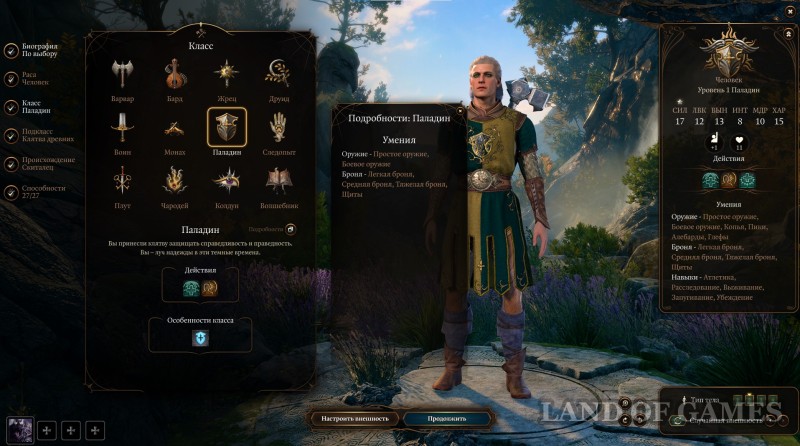
Еще один универсальный класс, который, как и жрец, может лечить и поддерживать союзников, а также танковать и наносить повреждения врагам в ближнем бою. Священный урон будет весьма кстати при сражении с нежитью. При исследовании мира его высокая Харизма поможет вам в убеждении собеседников.
| Плюсы | Минусы |
|---|---|
| Большой запас здоровья и тяжелая броня положительно влияют на живучесть Паладина. | Плохо показывает себя при сражении на дальних дистанциях. |
| Способен исцелять себя и товарищей по команде. | Имеет ограниченное количество заклинаний и свободных ячеек под них. |
| Большая харизма упрощает убеждение собеседников. | Клятва нередко ограничивает ответы в диалогах. |
| Может контролировать толпу с помощью некоторых способностей. |
Подклассы
- Клятва древних – наделяет аурой, блокирующей часть получаемого урона. Может исцелять себя и ближайших союзников. На 5-м уровне получает Туманный шаг, с помощью которого можно быстро сократить дистанцию с врагами или переместиться на другой край арены, чтобы подлечиться. Лучший сабкласс для Паладина.
- Клятва верности – может наделять союзников контратакой, а также позволяет использовать священное оружие и изгонять нечистых.
- Клятва возмездия – дает атакам дополнительный лучистый урон и шанс наложить дезориентацию на врагов. Может повышать свою скорость и пугать противников.
- Клятвопреступник (открывается в случае нарушения своей клятвы) – позволяет наносить некротический урон, брать под своей контроль вражескую нежить или усиливать союзную, и пугать ближайших противников.
Следопыт
- Роль в команде: дамагер ближнего и дальнего боя
- Основная характеристика: Ловкость
- Вторая по важности характеристика: Мудрость
- Особенности: Призыв фамильяра
- Доступные навыки: Атлетика, Скрытность, Расследование, Природа, Дрессировка и Выживание
- Рекомендуемые расы: человек, эльф, полуэльф, полуорк, тифлинг, гитьянки и дроу
- Спутник данного класса: Минск
- Ранг: B

Благодаря выбору Заклятого врага и Исследователя природы можно получить дополнительные способности и сопротивления для персонажа, однако они не способны переломить ход битвы. Рекомендуется собирать рейнджера на Ловкость и научиться эффективно применять парное оружие. На 2-м уровне, к сожалению, на 2-м уровне Следопыт получает не очень много заклинаний, причем почти все они носят ситуативный характер.
| Плюсы | Минусы |
|---|---|
| Высокие показатели скорости и здоровья, что повышает живучесть. | Незначительное количество заклинаний и слотов под них. |
| Может наносить большой урон на дальнем расстоянии. | Некоторые способности нуждаются в концентрации. |
| Может призывать спутников-зверей, получая от них различные бонусы. | В целом, не может похвастаться какими-либо выдающимися особенностями. |
Подклассы
- Повелитель зверей – позволяет призывать животных-спутников, которые могут помочь как в бою, так и при исследовании мира. У них может быть своя броня и навыки, что превращает их в весьма мощное подкрепление. Оптимальный сабкласс для Следопыта.
- Охотник – усиливает базовый архетип, позволяя выбрать еще один бонус для контратаки или нанесения дополнительных повреждений.
- Сумрачный охотник – направлен на скрытное ведение битвы. При выполнении первого удара он совершает дополнительную атаку, а также получает особое зрение в темноте. Этот сабкласс можно выбрать вместо Повелителя зверей, если вы хотите сделать упор на стелс.
Плут
- Роль в команде: дамагер с упором на скрытность
- Основная характеристика: Ловкость
- Вторая по важности характеристика: Выносливость
- Особенности: отсутствуют
- Доступные навыки: Ловкость рук, Скрытность, Обмен и Акробатика
- Рекомендуемые расы: человек, эльф, полуэльф, тифлинг, гитьянки, гном, полурослик и дроу
- Спутник данного класса: Астарион
- Ранг: B
Крайне полезный класс для исследования мира, так как с помощью него можно без проблем вскрывать замки, красть из карманов и обезвреживать ловушки. Однако в бою многое зависит от вашей удачи и обстановки. К примеру, можно быстренько пройти в спину к врагу, воспользовавшись Хитрым действием, вот только скрытый удар может провалиться, и тогда вы окажитесь на передовой без какой-либо поддержки и лишних ОД.
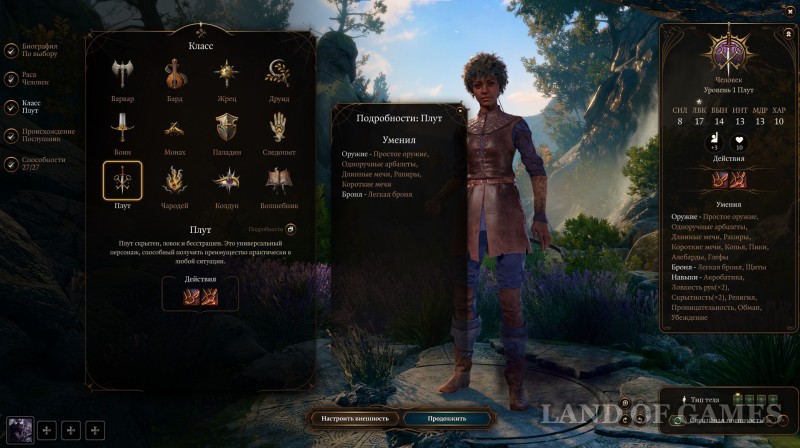
Так что мы советуем вам держать в отряде одного Плута (или его гибрида), чтобы при необходимости открывать запертые двери и воровать ценные предметы. Но при этом делать главного героя Плутом не рекомендуется.
| Плюсы | Минусы |
|---|---|
| Будет полезен любому отряду благодаря своим не боевым способностям. | Есть риск быстро лишиться жизни в случае провальной атаки исподтишка. |
| Наносит значительный критический урон скрытной атакой. | Может использовать только легкую броню и имеет малый запас ОЗ. |
| Обладает высокой мобильностью и немалым количеством ОД. | Не во всех битвах от него будет польза. Имеет малое число заклинаний. |
Подклассы
- Вор – дает устойчивость к урону от падений и дополнительные ОД, что позволяет Плуту совершать еще больше действий за ход. Лучший вариант сабкласса для данного архетипа.
- Мистический трикстер – дает Плуту еще больше заклинаний, создающих иллюзии и очаровывающих врагов. Своеобразный гибрид разбойника и мага. С помощью магической руки он сможет передвигать вещи.
- Убийца – повышает боевые способности Плута, позволяя ему наносить еще больше критов при ударе в спину врагов.
Чародей
- Роль в команде: дамагер-заклинатель (стеклянная пушка)
- Основная характеристика: Харизма
- Вторая по важности характеристика: Выносливость
- Особенности: Открыты ячейки заклинаний 1-го круга
- Доступные навыки: Магия, Религия, Проницательность, Обман и Убеждение
- Рекомендуемые расы: эльф, полуэльф, тифлинг, дроу, человек и гном
- Спутник данного класса: отсутствует
- Ранг: А
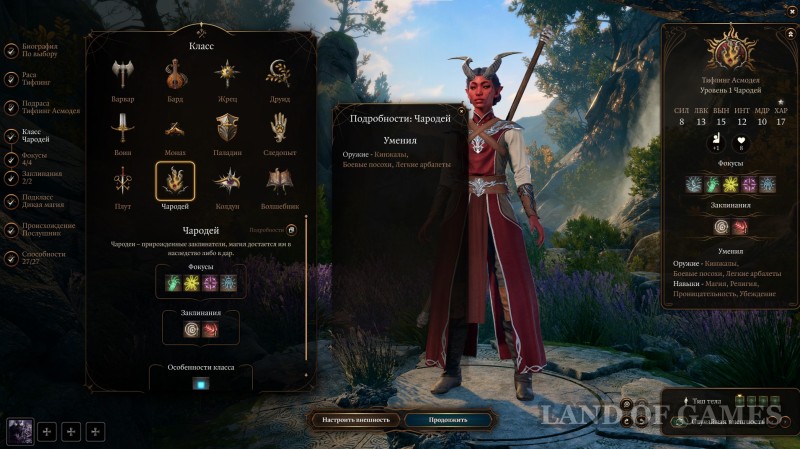
Этот класс получает магические силы в зависимости от происхождения, из-за чего считается более узконаправленным магом, чем, к примеру, Волшебник. Благодаря высокой Харизме может выполнять функцию дипломата в отряде. Используя метамагию, Чародей может модифицировать заклинания, изменяя продолжительность их действия, дальность поражения или эффективность. Вот только он обладает сравнительно малым запасом здоровья и не может использовать броню, из-за чего придется постоянно следить за ним в бою.
| Плюсы | Минусы |
|---|---|
| Может нанести значительный урон по площади своими заклинаниями. | Ограничен в использовании оружия. |
| Может модифицировать чары, подгоняя их под ситуацию. | Не может использовать броню и имеет мало здоровья, из-за чего враги могут запросто убить его. |
| Высокая харизма помогает убеждать собеседников. | Очки чародейства не бесконечны. |
Подклассы
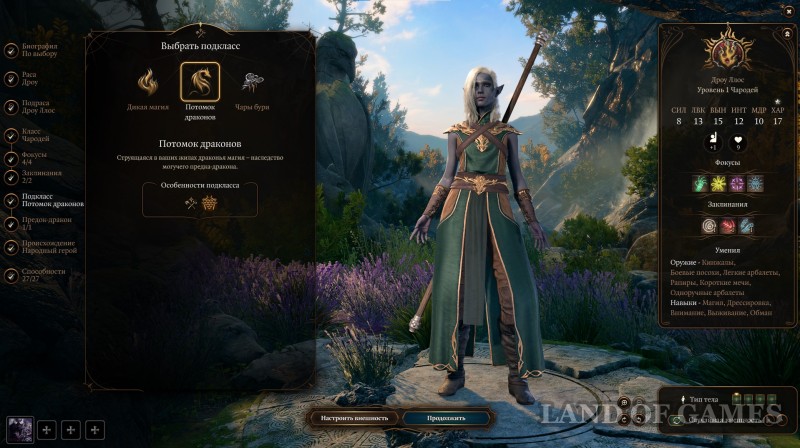
- Потомок драконов – повышает класс брони при отсутствии доспеха, дает больше здоровья и наделяет дополнительной способностью (советуем взять красного или белого дракона). Оптимальный сабкласс для чародея, который позволяет хоть как-то снизить его хрупкость.
- Дикая магия – создает хаотичные заклинания, случайно усиливая их. Иногда они могут переломить ход боя, однако в некоторых случаях спеллы могут сработать против вас.
- Штормовое колдовство – наделяет Чародея возможностью полета, причем враги не будут атаковать вас, если пролетите мимо них.
Колдун
- Роль в команде: универсальный дамагер-заклинатель
- Основная характеристика: Харизма
- Вторая по важности характеристика: Выносливость
- Особенности: Ячейки заклинаний колдуна
- Доступные навыки: Магия, История, Расследование, Природа, Религия, Обман и Запугивание
- Рекомендуемые расы: эльф, полуэльф, тифлинг, дроу, человек и гном
- Спутник данного класса: Уилл
- Ранг: А
Хоть речь идет о маге, но он способен использовать легкую броню и простое оружие. Большой выбор заклинаний же делает его весьма универсальным классом, который будет полезен почти в любой ситуации. Ячеек для спеллов меньше, чем у других магических архетипов, зато их обновление происходит даже после непродолжительного отдыха.

Благодаря высокой Харизме его следует использовать при разговоре с другими людьми. Правда, если Чародей специализируется на убеждении, то Колдун – на запугивании. Советуем выбрать парочку заклинаний Школы эвокации для повышения эффективности этого архетипа.
| Плюсы | Минусы |
|---|---|
| Может восстанавливать заклинания при коротком отдыхе. | Имеет сравнительно малое число заклинаний и пустых ячеек под них. |
| Универсальный заклинатель, который будет полезен в любой ситуации. | Не имеет какой-либо специализации, из-за чего в некоторых случаях его можно охарактеризовать как «ни рыба, ни мясо». |
| Высокая харизма упрощает переговоры. | Зависит от Потустороннего разряда в случае расхода всех слотов заклинаний. |
Подклассы
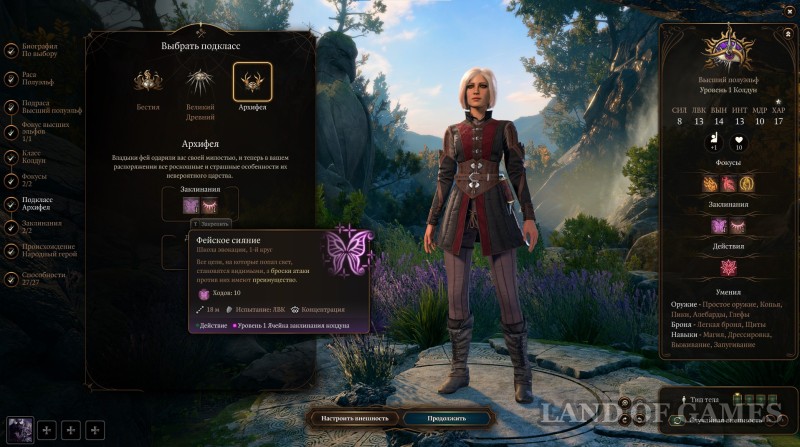
- Бестия – позволяет высасывать временное здоровье из погибших врагов, что повышает живучесть Колдуна. Оптимальный сабкласс.
- Великий Древний – наделяет полезными заклинаниями для контроля противников. При нанесении критического удара цель и ее ближайшие союзники могут получить дебафф испуг.
- Архифея – наделяет полезными заклинаниями для контроля противников. Колдун становится невосприимчив к очарованию и получает способность к телепортации.
Волшебник
- Роль в команде: чистый дамагер-заклинатель
- Основная характеристика: Интеллект
- Вторая по важности характеристика: Выносливость
- Особенности: Открыты ячейки заклинаний 1-го круга
- Доступные навыки: Магия, История, Расследование, Природа, Религия, Проницательность и Медицина
- Рекомендуемые расы: эльф, полуэльф, тифлинг, дроу, человек и гном
- Спутник данного класса: Гейл
- Ранг: А
Этот класс обладает огромным количеством самых разнообразных заклинаний. Разве что нет чар на исцеление. Его тоже можно назвать «стеклянной пушкой» из-за отсутствия брони и малого здоровья, однако он более гибкий, чем Чародей, к примеру, его можно использовать не только как дамагера, но и саппорта.
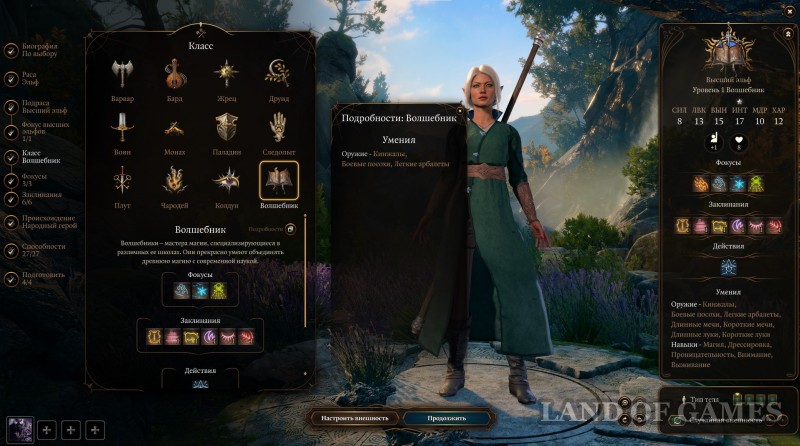
С помощью Магического восстановления он может создавать новые слоты под заклинания и изучать дополнительные чары из свитков, тратя всего 50 золотых монет.
| Плюсы | Минусы |
|---|---|
| Легко адаптируется к ситуации благодаря большому количеству заклинаний. | Нужно заранее подготавливать заклинания из-за их огромного разнообразия. |
| Может контролировать толпу или баффать союзников. | Когда заклинания заканчиваются, становится бесполезным в битве. |
| Способен нанести огромный урон по площади. | Самый хрупкий магический класс, поэтому нужно постоянно следить за его состояние в бою. |
| Нужно осторожно применять AoE-заклинания, чтобы случайно не задеть союзников. |
Подклассы
- Школа эвокации – позволяет наносить огромный урон по площади и при этом блокировать повреждения по союзникам. Оптимальный сабкласс, дающий возможность без опаски метать огненные шары по противникам.
- Школа ограждения – направлена на магическую защиту себя и союзников.
- Школа вызова – позволяет создавать материю, предметы и созданий, а также переместиться в определенное место без расхода слотов заклинаний или поменяться местами с товарищем по команде. Во время прокачки не лишается концентрации.
- Школа прорицания – наделяет высоким восприятием, а также позволяет менять значения бросков и восстанавливать потраченные слоты заклинаний.
- Школа очарования – позволяет накладывать на создания гипноз и перенаправлять атаки противников на другую цель.
- Школа некромантии – позволяет восстанавливать здоровья от трупов противников и поднимать тела умерших врагов. Дает защиту от некротической энергии.
- Школа преобразования – позволяет создать особый камень с разными бонусами и превращаться в животное на высоких уровнях.
- Школа иллюзии – позволяет создавать разные иллюзии и обманки для отвлечения.
Лучшие классы в Baldur’s Gate 3
В игре нет мастера на все руки, который может и наносить огромный урон, и лечить союзников, и танковать противников, и делать множество других вещей. Однако есть ряд архетипов, которые выполняет свои функции лучше других и зачастую являются универсальными бойцами. В таблице ниже указан рейтинг всех имеющихся классов в Baldur’s Gate 3 и их основные роли.
| Ранг | Класс (роль) |
|---|---|
| S |
Бард (саппорт)
Жрец (саппорт/хилер)
Паладин (саппорт/хилер/танк) |
| A |
Варвар (дамагер/танк)
Воин (дамагер/танк)
Чародей (дамагер)
Колдун (дамагер)
Волшебник (саппорт/дамагер) |
| B |
Следопыт (дамагер)
Плут (дамагер)
Друид (саппорт/танк) |
| C |
Монах (дамагер) |
Какой класс выбрать
Если вы впервые играете в подобные ролевые игры, то мы советуем вам взять что-нибудь попроще, например, архетип Воина (Чемпион) или Варвара (Берсерк), которые не требуют больших познаний в тактике и стратегии – нужно просто посылать их в гущу врагов, применяя стандартные способности.
Тем, кто хочет поддерживать своих союзников и/или лечить их, следует взять Барда или Жреца. Если хотите также танковать и наносить урон, то выберите Паладина. Все три класса принесут огромную пользу команде.
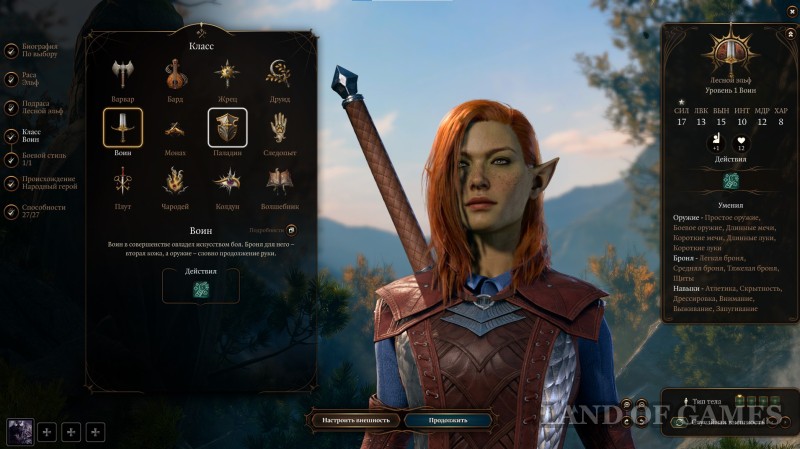
Желаете наносить огромный урон врагам с безопасного расстояния? Тогда возьмите любой магический класс. Чародей – это полноценный ДД с малой защитой, Колдун – более крепкий, но наносит меньше урона, а Волшебник – может дамажить по площади и баффать союзников.
Любителям наносить скрытные атаки стоит выбрать Плута или Следопыта. Однако сразу предупредим, что у них присутствуют серьезные минусы, о которых мы указали выше. С другой стороны в игре нет откровенно плохих классов, поэтому при должной прокачке пользу способен принести любой из них.
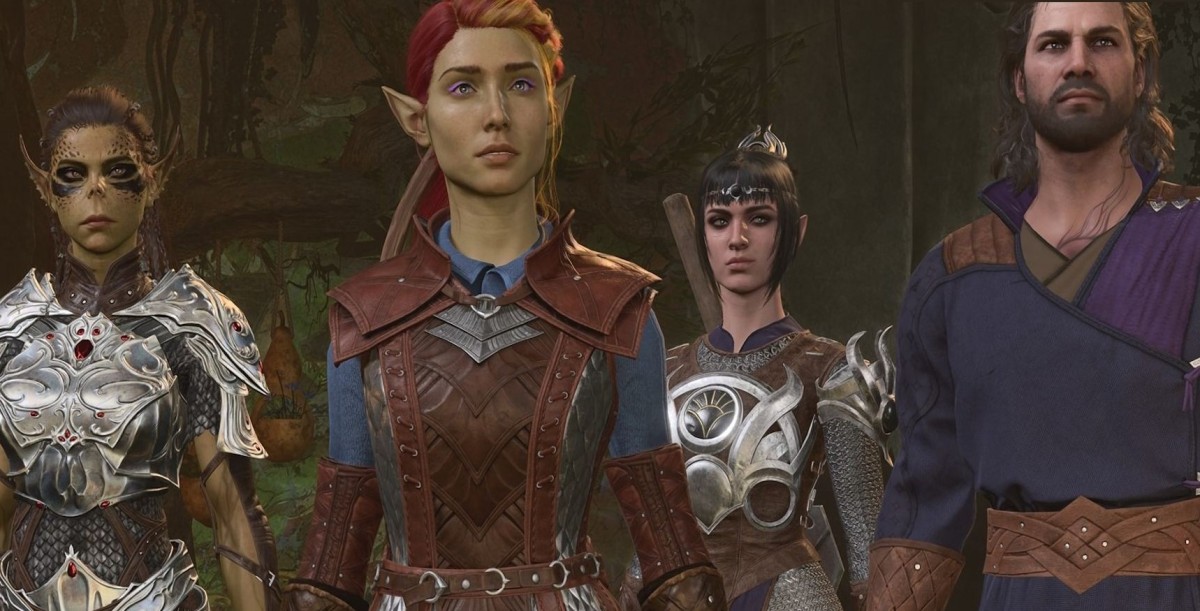












Комментарии
Для добавления комментариев необходимо авторизоваться.
Вы можете войти через